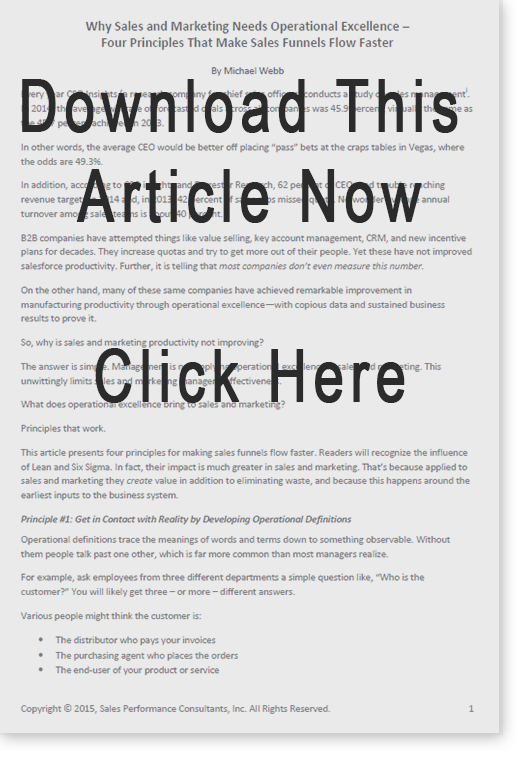Why Sales and Marketing Needs Operational Excellence – Four Principles That Make Sales Funnels Flow Faster
 Every year CSO Insights (a research company for chief sales officers) conducts a study on sales management1. In 2014, the average win rate of forecasted deals across all companies was 45.9 percent, virtually the same as the 45.7 percent achieved in 2013.
Every year CSO Insights (a research company for chief sales officers) conducts a study on sales management1. In 2014, the average win rate of forecasted deals across all companies was 45.9 percent, virtually the same as the 45.7 percent achieved in 2013.
In other words, the average CEO would be better off placing “pass” bets at the craps tables in Vegas, where the odds are 49.3%.
In addition, according to CSO insights and Forrester Research, 62 percent of CEOs had trouble reaching revenue targets in 2014 and, in 2013, 42 percent of sales reps missed quota. No wonder average annual turnover among sales teams is about 40 percent.
B2B companies have attempted things like value selling, key account management, CRM, and new incentive plans for decades. They increase quotas and try to get more out of their people. Yet these have not improved salesforce productivity. Further, it is telling that most companies don’t even measure this number.
On the other hand, many of these same companies have achieved remarkable improvement in manufacturing productivity through operational excellence—with copious data and sustained business results to prove it.
So, why is sales and marketing productivity not improving?
The answer is simple. Management is not applying operational excellence in sales and marketing. This unwittingly limits sales and marketing manager’s effectiveness.
What does operational excellence bring to sales and marketing?
Principles that work.
This article presents four principles for making sales funnels flow faster. Readers will recognize the influence of Lean and Six Sigma. In fact, their impact is much greater in sales and marketing. That’s because applied to sales and marketing they create value in addition to eliminating waste, and because this happens around the earliest inputs to the business system.
Principle #1: Get in Contact with Reality by Developing Operational Definitions
Operational definitions trace the meanings of words and terms down to something observable. Without them people talk past one other, which is far more common than most managers realize.
For example, ask employees from three different departments a simple question like, “Who is the customer?” You will likely get three – or more – different answers.
Various people might think the customer is: 
- The distributor who pays your invoices
- The purchasing agent who places the orders
- The end-user of your product or service
- The executive decision-maker
How can meaningful change occur when people are unclear on such a basic concept?
This applies to the entire sales and marketing lexicon. Ask yourself what standards you use to answer crucial questions like, “If a salesperson calls on a customer for six months without winning an order, how do we know if they’ve created value or waste?” Or, “How do we know whether it is better to invest in a new lead generation campaign or to hire more salespeople?” Or, “How do we know what the customer really values?”
Every business needs clear, simple answers to such questions. They cannot be “handed down from on high,” however. They must be developed jointly by sales, marketing, and service people through observation, discussion, and experimentation as markets and technologies change. This enables problems to be studied.
Principle #2: Locate Causes of Problems by Understanding Variation
Customers and prospects vary not just in size and location, but also in their problems and in their awareness and motivation to solve them. Some variations are more important than others, of course. Studying the qualities of leads, prospects, and sales opportunities is a form of Voice of Customer that enables you to measure and analyze the inner workings of your deal flow.
For example, operationally defining qualification criteria causes salespeople to prioritize their prospects in more similar ways. I’ve seen this increase close ratios by 50 percent in 60 to 90 days, while increasing forecast accuracy to more than 90 percent. Likewise, a medical device manufacturer learned their product required vastly different value propositions when selling to inner city hospitals than when selling to well-funded teaching hospitals in the suburbs.
Getting a handle on variation provides data that reveals potential causes of sales and marketing problems.
Principle #3: Find Changes That Cause Improvement by Engaging in Systems Thinking
Sales and marketing defines a value stream—the stages your customers go through to realize, prioritize, and solve their problems. Data from field activity reveals bottlenecks, so you can focus your precious resources where they will provide the greatest return. This means you can systematically work your way from eliminating your internal bottlenecks to improving your external customers’ processes.
For example, a few years ago, one company’s customers had difficulty reordering replaceable filters – and no wonder. A website, a call center, a network of distributors, and a team of service people were all involved, but not connected. With a bit of systems thinking and some new technology, they piloted some new approaches. One of these was filters that electronically signaled for their replacement on reaching certain usage levels. Solving these internal issues locked in refill orders, reducing cycle times and lowering costs.
As customers use the Internet and mobile devices to solve their problems and revamp their buying processes, seeing your own business from their perspective is critical. A 2014 study by Google and the Corporate Executive Board2 revealed that B2B companies increasingly avoid contact with salespeople until the last possible moment. To meet this challenge, companies must provide the information and problem-solving services customers want by integrating marketing techniques, web-based tools, communication technologies, and salespeople’s efforts into a predictable, self-improving sales production system.
Just a few years ago a capital equipment company’s salespeople spent weeks cold calling and networking to find prospects. When they published a free website that helped diagnose problems that could lower their customer’s production costs, it attracted high-quality visitors. When those visitors mentioned time-sensitive needs, they were connected to the right salespeople. Helping external customer’s solve their problems sped up sales cycles, and increased deal flow and perceived value, not to mention close ratios and customer satisfaction as well.
Finding and solving bottlenecks makes your sales funnel flow faster. Yet it cannot happen unless management actively supports learning and improving across departments.
Principle #4: Make Sales Funnels Flow Faster by Enabling Your People to Learn and Improve
In most organizations marketing and sales still operate in separate silos. Marketing still deploys programs with little coordination with sales. Sales meetings are still exercises in determining whether the salespeople are winning the deals on the forecasts that are less than 50 percent accurate, as noted in the opening of this article.
Marketers, sellers, and servicers don’t really want this. And they can’t change their ways without the right leadership and support. Operational excellence principles are the structure for learning and improving. They require abundant open, honest communication between workers and managers about what improvement is possible as well as how to achieve it. This should become an expected element of every sales and marketing management cycle. Such a method contrasts sharply with current reality.
Conclusion
How do senior leaders provide that leadership and support?
They become incessantly curious about how their people work, and what they think they need to improve. Everyone loves being respected for achieving increasing targets they set for themselves. In other words, people work incredibly hard for the pleasure of being in a company that listens and takes them seriously.
These principles set management on a path toward a fundamental, and extremely positive, change in the character of sales and marketing management.
About the Author
Michael Webb is author of “Sales and Marketing the Six Sigma Way,” and founder of SPC, Inc., a firm dedicated to helping B2B companies solve their sales and marketing problems and make their sales funnels flow faster through operational excellence. His new book, Sales Process Excellence, is the definitive guide to how operational excellence changes and improves B2B sales and marketing management. Download the Introduction and Chapter 1 at www.salesprocessexcellence.com.
Reference:
1: https://www.xactlycorp.com/resources/guides-old/cso-insights/
2: http://www.executiveboard.com/exbd-resources/content/digital-evolution/pdf/Digital-Evolution-in-B2B-Marketing.pdf

